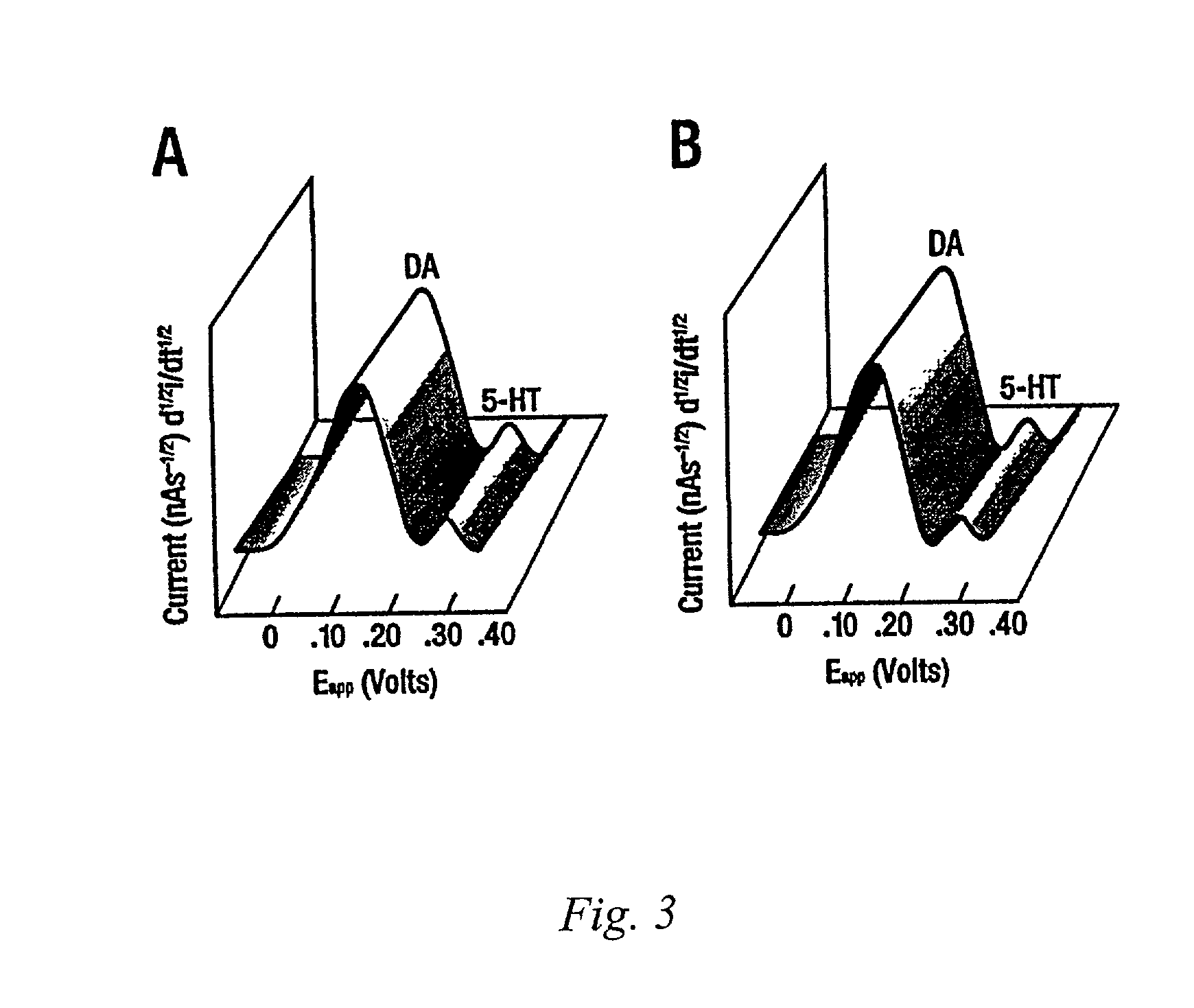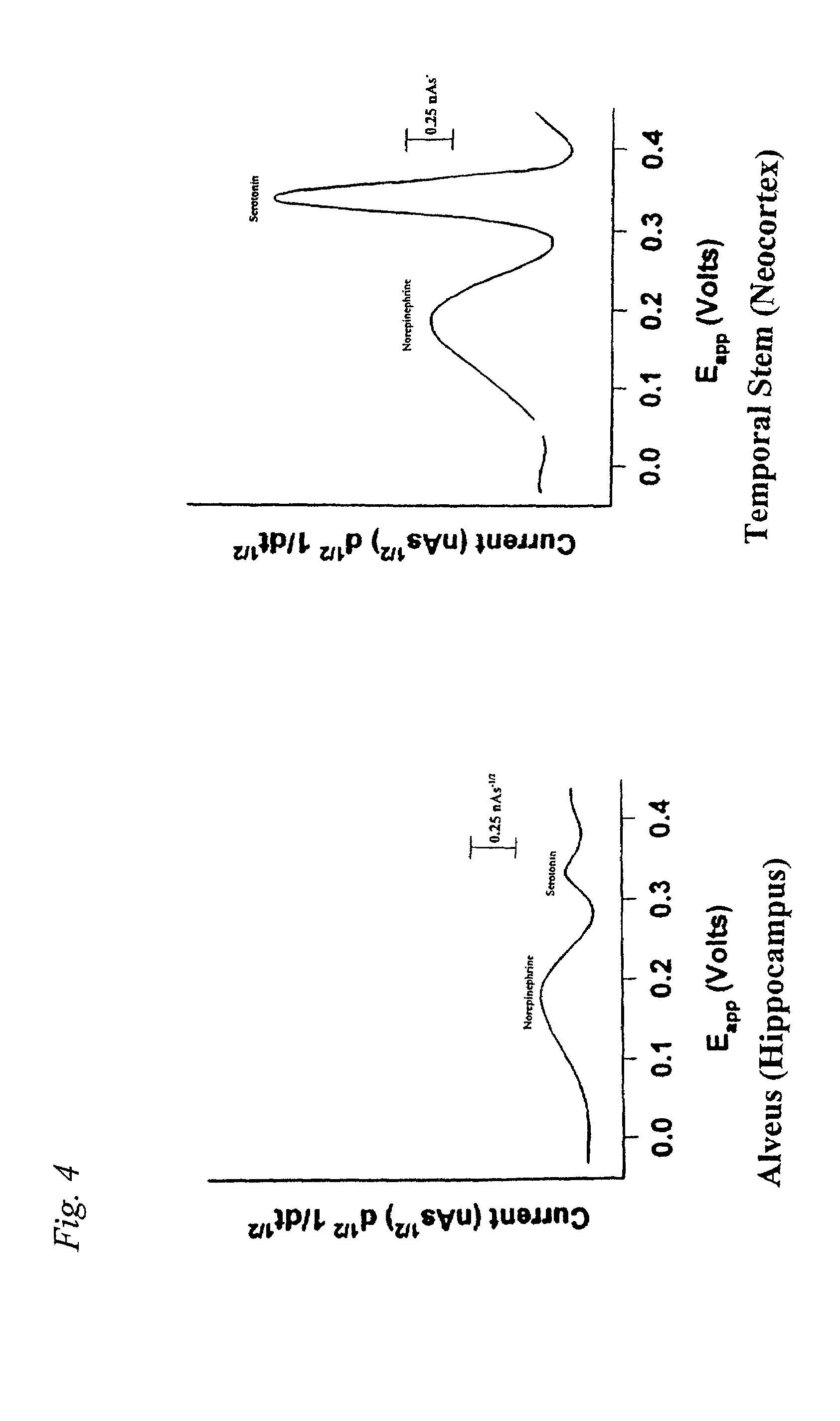Identification, diagnosis, and treatment of neuropathologies, neurotoxicities, tumors, and brain and spinal cord injuries using microelectrodes with microvoltammetry
a microvoltammetry and microelectrode technology, applied in the field of identification, diagnosis, treatment of neuropathologies, neurotoxicities, tumors, brain and spinal cord injuries, can solve the problems of insufficient linear diffusion, insufficient in vitro analysis techniques, and criticized techniques, and achieve the effect of reliably distinguishing temporal lobe gray matter, diagnosing and treating cocaine psychomotor stimulant behaviors
- Summary
- Abstract
- Description
- Claims
- Application Information
AI Technical Summary
Benefits of technology
Problems solved by technology
Method used
Image
Examples
example 1
Human Epilepsy
[0080]Fourteen patients who had temporal lobectomies for intractable seizures were studied. Patients underwent intraoperative surgery within the same time period and were studied in order of time, within the same time period. Patients were classified as having mesial temporal lobe epilepsy if pathologic examination of the resected temporal lobe revealed severe hippocampal neuronal loss and gliosis and if examination of the neocortex revealed no other etiology for the patient's epilepsy. Nine patients were classified as mesial temporal lobe epilepsy based on these features. Five patients were classified as having neocortical temporal lobe epilepsy based on the lack of hippocampal atrophy on magnetic resonance imaging (MRI) and demonstration of seizure onset in temporal neocortex during chronic intracranial EEG study with lateral temporal subdural grid electrodes and multiple baso-mesial temporal subdural strip electrodes.
[0081]FIG. 1 shows a schematic diagram of a Brode...
example 2
Human Epilepsy
[0093]Significant differences in the monoamine signatures from the hippocampal subparcellations in patients with MTLE and NTLE have been observed. The alveus (hippocampal white matter) contains both efferent fibers from hippocampus that form the fornix and afferent pathways connecting entorhinal cortex and the CA1 region of the hippocampus. The neurochemistry of the alveus in patients with MTLE and NTLE was studied to determine whether similar neurotransmitter alterations exist.
[0094]Microvoltammetry with Broderick probe stearic acid microelectrodes was used to detect norepinephrine (NE), dopamine (DA), ascorbic acid (AA), and serotonin (5-HT) in resected temporal lobes of 9 MTLE and 4 NTLE patients with temporal lobe epilepsy. Neurotransmitters were detected in separate signals within the same recording within seconds in alveus by experimentally derived oxidative potentials, determined in vitro in Ringers Lactate or PO4 buffer. Ag / AgCl reference and stainless steel au...
example 3
Distinguishing White and Gray Matter
[0097]Voltammetric signals were analyzed from microelectrodes in resected temporal lobes to determine whether gray and white matter structures could be reliably distinguished.
[0098]Microvoltammetry with Broderick Probe stearic acid microelectrodes was used to detect norepinephrine (NE), dopamine (DA), ascorbic acid (AA), and serotonin (5-HT) in 40 grey matter structures and 37 white matter structures in resected temporal lobes of a total of 14 patients with temporal lobe epilepsy. Neurotransmitters were detected in separate signals within the same recording within seconds in 3 gray matter (temporal neocortex, hippocampal pyramidal, and dentate gyrus granular layer) and 3 white matter structures (temporal stem, subiculum, and alveus), by experimentally derived oxidative potentials, determined in vitro in Ringers Lactate or PO4 buffer. Ag / AgCl reference and stainless steel auxiliary microelectrodes were placed in each specimen 4–6 mm from indicator ...
PUM
 Login to View More
Login to View More Abstract
Description
Claims
Application Information
 Login to View More
Login to View More - R&D
- Intellectual Property
- Life Sciences
- Materials
- Tech Scout
- Unparalleled Data Quality
- Higher Quality Content
- 60% Fewer Hallucinations
Browse by: Latest US Patents, China's latest patents, Technical Efficacy Thesaurus, Application Domain, Technology Topic, Popular Technical Reports.
© 2025 PatSnap. All rights reserved.Legal|Privacy policy|Modern Slavery Act Transparency Statement|Sitemap|About US| Contact US: help@patsnap.com



